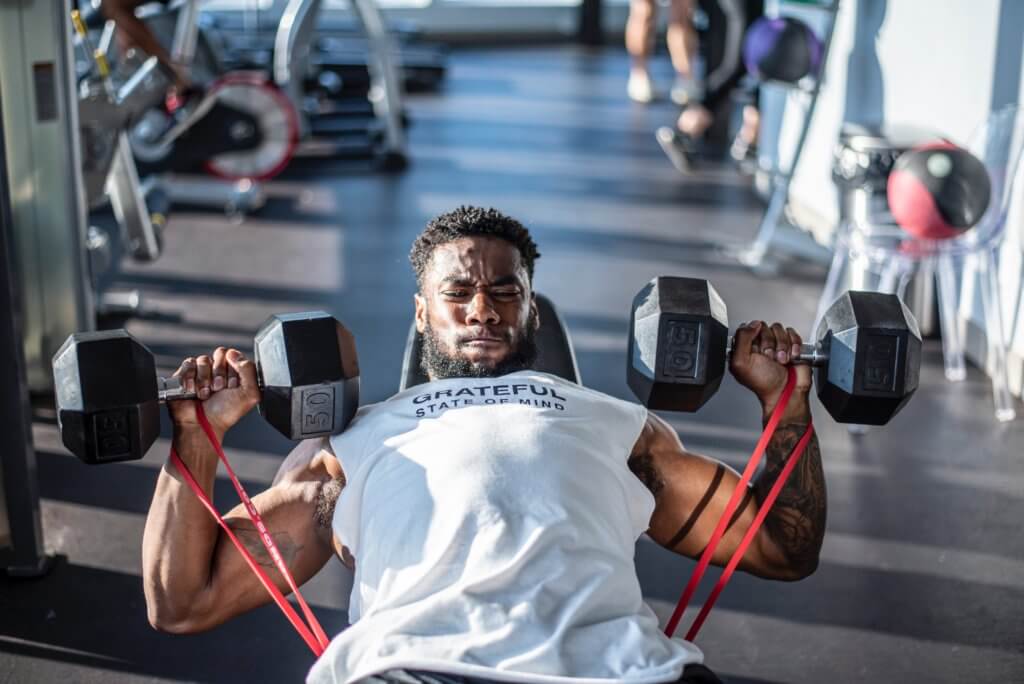HAMILTON, Ontario — There are endless workout routines and plans out there to choose from when it comes to building strength and growing muscle, but a surprising new study out of Canada indicates it really doesn’t matter how you go about weightlifting. What matters is simply getting in the weight room consistently and breaking a sweat. Researchers from McMaster University report that regardless of whether you use heavy or light weights, just lifting them as many times as you can is enough to build both strength and muscle.
All in all, study authors say the specific details of weightlifting don’t matter as much as making a habit of the practice in general. The team reached these conclusions by analyzing some of the most popular variables among resistance training programs (how much someone is lifting, how often, and how many times). This approach led the team of kinesiologists to discover that all forms of resistance training are beneficial, including body-weight exercises like planks, lunges, and push-ups.
“There are a dizzying number of factors and combinations to consider when creating a weightlifting program to maximize strength and muscle growth,” says Stuart Phillips, a kinesiology professor who conducted the work with graduate students Bradley Currier and Jonathan Mcleod, in a media release.
“This is an age-old debate among athletes and strength and conditioning coaches: what combination leads to the best gains?”

Researchers analyzed a total of 192 randomized, controlled studies encompassing a total sample size of over 5,000 people, with participants being evenly split between men and women. This project was the single largest of its kind to date.
Moreover, study authors say their work is the culmination of years of planning, collecting, and analyzing massive amounts of data centered on three essential resistance-training variables: higher versus lower loads, single versus multiple sets, and training frequency (one, two, three or more) sessions weekly.
The vast majority of fitness experts currently espouse the belief that using very heavy weights (that many people can only lift three to five times) is the best way to build strength. Alternatively, most believe that using weights they can lift eight to 10 times works best for building muscle size.
Yet, based on prior work, the team at McMaster have spent the last 10+ years disputing the notion that heavier weights are the only option to really build strength.
Prof. Phillips and his team have published several papers displaying that significant gains are indeed possible when lifting lighter weights to the point of exhaustion. More specifically, that can entail 20 to 30 repetitions, and in some cases even more.

During this latest comprehensive review of relevant research, study authors discovered that in order to maximize muscle strength, lifting heavier weights is most effective. However, if one’s goal is to maximize muscle size, one should perform each exercise several times – the weight being lifted isn’t as important.
“Our analysis shows that every resistance training prescription resulted in strength and muscle mass gains. Complex prescriptions are sufficient but unnecessary to gain strength and muscle. Simple programs are extremely effective, and the most important result is that people can benefit from any weightlifting program,” Currier explains. “Seek guidance if you are unsure where to begin and how to progress, but it doesn’t need to be complicated.”
In conclusion, the research team notes that this analysis is generally good news for everyone, regardless of their age, looking to build strength and maintain more muscle. Sustaining muscle throughout life is key to preventing injury, maximizing mobility, and optimizing metabolism.
“The biggest variable to master is compliance,” Mcleod concludes, “Once you’ve got that down, then you can worry about all of the other subtle nuances, but our analysis clearly shows that many ostensibly important variables just aren’t that essential for the vast majority of people.”
The study is published in the British Journal of Sports Medicine.
You might also be interested in:
- Bigger muscles in half the time: Weight lowering (not lifting) key to boosting strength, size
- Lifting weights for just 3 SECONDS a day can improve muscle strength!
- Lifting weights beats out cycling, swimming for vegans wanting stronger bones


I’m 82 started lifting when I turned 50 from office work to doing stone work.i was suffering from depression PTSD for 25 years counseling ,weight lifting, and healthy eating I feel extend my life and free me of PTSD and depression with a weight loss of 50 lbs. I was benching 300 lbs at the age of 72 however high blood pressure and separation of my ligaments in both knees from skydiving put me on hold for 9 years . I currently lift light weights a slow 10 seconds and get one heck of a burn. Compared to lifting heavy weights to me I never really got a burn like I did with the slow movement weight training. Also less chance of getting hurt. I contribute my recover from high blood pressure, learning how to walk, surviving COVID and septic, to weight training, healthy diet,not smoking and not drinking. I have only 50 percent range of motion which only allows me to piggy back skydiving. I also returned to doing stone work. I really think my mussels have memory been lifting for 6 months my arms are 16 inches compared to 17 inches wend I was 72. Yes I agree you can still maintain mussel growth at any age with weight training. Keep encouraging people to go to the gym God bless!!!
Next, study the effects of these bigger muscles on the joint health, over time.
The best way is to exhaust each muscle group totally. That is by working down the stacks until you can no longer lift the smallest weight. Muscles strengthen by actually tearing them down and then restitching back together the micro tears that strength training causes. Can only do this every other day at most since the muscles need time to reknit. Ideally to be done three times a week at most.